In Cuba, a lot of things don’t work quite right. A six-lane superhighway ends abruptly in a cane field and then continues as a two-lane blacktop. Early 1950’s Cadillacs, Chevies, Fords, DeSotos, Studebakers and countless Ladas belch black smoke but continue to transport Cubans. Because of overconcentration on sugar cane from 1960 to 1990, the country’s fertile soil, which could feed 30 million people, cannot feed 11 million, and hard currency must be spent importing food.
However, some things in Cuba work quite well. Cuba has the longest life expectancy of any country in Latin America; the best free medical care of any country in the Western Hemisphere; a lower infant mortality rate than does the United States; the most comprehensive free educational system in Latin America; almost 100% literacy; nearly 100% electrification.
These are achievements of the Revolution of 1959. This accounts for the massive public support for the revolutionary government despite its mistakes, occasional corruption, and political heavy-handedness. But there is another achievement, seldom examined, directly attributable to Cuban socialism and the Revolution. Cuba has the most original, diverse, and thriving visual and performing arts of any country its size in the world.
It is this latter phenomenon that we, 12 travelers from the United States, went there to observe and examine. This was an “Art and Architecture Tour,” licensed by the State Department as part of the “people to people” exception to the U.S. blockade/embargo on tourism to Cuba. In the course of this tour we heard much about Cuba’s leading artists, and much about the art of leading Cuba.
We were a cohesive group, 12 old and new friends and comrades, led by Sandra Levinson, executive director of the Center for Cuban Studies in New York. Sandy has made more than 300 trips to Cuba since the 1959 Revolution. We had all agreed to meet in Miami at the Airport Hotel, March 14, 2013, the day before we were to fly to Havana. Amazingly we all made it, with participants coming from New York, Michigan, and Hawaii.
On Friday, March 15, we got up early, having been advised of a long processing prior to boarding our 2:30 pm flight to Havana. We tried not to think of Cubana Airlines Flight 455, blown up in 1976 by right-wing Cuban exiles. We boarded on time and the one-hour flight was uneventful. A man, sitting in front of my wife, Barbara, wept. He was going to visit his family in Cuba for the first time in 16 years. The Obama administration had finally relaxed travel restrictions for Cuban families. A big cheer went up among the Cubans on board as we touched down in Havana. No bombs. And the old gusanos in Miami were another day closer to death and further from counterrevolution.
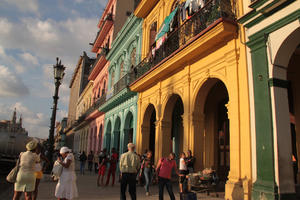
Meeting us at the Havana terminal was our in-country guide, Jesús Noguera, a cheerful, fit young man in his 40s. He was well informed and spoke excellent English. We boarded a small Amistur tour bus and drove to the Hotel Saratoga, one of a handful of classy old hotels the government has allowed foreign investors to refurbish and manage. Jesús said that, historically, Fidel welcomed tourists but eschewed heavy investment in tourism, regarding it as demeaning and a source of corruption, prostitution and narcotics trafficking. His brother Raúl sees it otherwise and is taking the necessary steps to upgrade tourist facilities and capture sorely needed hard currency.
On the way to our hotel we drove along the Malecón, Havana’s seaside boardwalk. The route was lined with what seemed to be deserted luxury apartments and mansions, until one looked closer and saw the empty window frames draped with occupants’ clothes lines, less glamorous than the brocaded drapes of the prior, affluent residents. We passed the Nacional hotel, formerly part of the Havana archipelago of hotels, show bars, casinos and brothels controlled, pre-Revolution, by Santos Trafficante Jr., Meyer Lansky, and others. These gangsters have long since been arrested and expelled from Cuba and their property confiscated. The Nacional is still open, without the casino, but with Desi Arnaz style floor shows called tropicanas for the tourists.
On first impression, Havana appeared to be a curious mix of graceful residential neighborhoods with boulevard streets, lovely pastel colonial homes and well-tended parks, and a funky Centro comprised of half deserted Spanish-era public buildings, some fortifications and a few pedestrian streets with tourist-oriented shops and bars (two stating they were Hemingway hangouts). We soon learned that many of the “deserted” buildings contained studios, galleries, restaurants, nightclubs, and bookstores. Our itinerary was full, and most of the days and nights we traveled as a group. However, when in a studio, school, gallery, or private home we were not rushed and were free to talk to anyone present or in the vicinity.
The art we observed was as varied and original as that to be seen in New York galleries. Twenty-six-year-old Havana avant garde artist Mabel Poblet worked on a large scale in a small apartment. She constructed self-portraits from tiny photos that, when arranged on a board the size of a ping pong table, formed the likeness of her face, somewhat like the works of Chuck Close, but with the photos painstakingly raised on pins to create an illusion of depth.
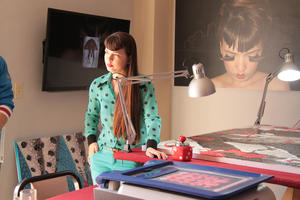
In a modest residential district the internationally known sculptor and painter Kcho has a studio in which he constructs huge figures and installations made of scrap lumber, driftwood, and old rowboats. In his workshop he teaches local residents the operation of wood and metalworking lathes, drills, and saws. He also paints or directs the painting of murals on public walls and in playgrounds. Many of the current murals featured the likeness of the late Venezuelan president, Hugo Chávez.
The sunlit seaside studio/home of Sandra Dooley was the perfect place to view the painting and ceramics of this self-taught Cuban of part-Scottish ancestry. Her work was impressionistic, representational, and often illustrative of Cuban folk tales and myths. She engaged local residents as assistants, encouraged development of their artistic skills, and displayed their work.
A one-hour bus ride took us to the community of Las Terrazas. Farmers once sowed their crops on terraces in the hilly terrain. This idyllic, forested setting on a river in the San Rosario hills is designated an environmentally protected “biosphere” where only original residents and artists can live but any other Cubans can visit and picnic.
Not surprisingly, artists in this community tend to concentrate on pastoral settings and depictions of the flora and fauna around them. Lester Campa, a painter and printmaker, works with bark and driftwood. Jorge Duporte, a self-taught artist, specializes in precise Audubon-like paintings and drawings of plants and birds. Many of his botanicals relate to the novels of one of Cuba’s most distinguished authors, Alejo Carpentier.
In Havana’s graceful tree-shaded Vedado district we visited the home and studio of artists Alicia Leal and Juan Moreira. Their work is highly symbolic, incorporating Catholic, Santeria, and secular Cuban iconography, as well as graphic explorations of sexuality. Their studio also displayed the work of conceptual photographer Grenacia Moreina and of Reynier Leyva Novo. Reynier’s work incorporates themes from early Soviet art and posters, prior to the Stalinist imposition of Socialist Realism.
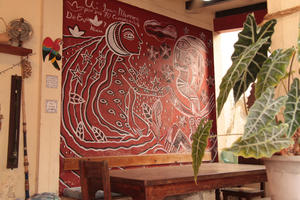
We noticed in Cuban works of art the frequent incorporation of the shape of the island of Cuba; the depiction of the pattern and/or the colors of the Cuban flag; the unmistakable likeness of the national hero, Jose Marti, with his waxed mustache; Catholic and Santeria icons; and themes of sexuality and gender.
The hyperactive ceramist José Rodríguez Fuster, known simply as Fuster, lives and works in the Jaimanitas district of Havana. He has, among a multitude of civic projects, adorned entire blocks of his neighborhood with tiles and mosaics, creating Gaudi-like towers, murals, giant chess sets, and shining waves of color across his own and fellow residents’ garden walls, garage doors, gates, balconies, and roofs. Sections of a sidewalk wall were reserved for the placement of tiles painted by other Cuban artists. His murals enliven the walls of a local Vedado athletic complex.
In Centro Havana we spent time with William López who, among other things, makes full-size cast iron replicas of rhinoceroses and miniature grand pianos with sounding boards in the shape of Cuba.
We squeezed in a side trip to the barbershop/salon of Gilberto “Papito” Valladares, Havana’s premier hair stylist and founder of the art project ArteCorte. His shop is on the third floor of a centuries-old building near Havana’s Malecón. The place is dreamlike with 18-foot ceilings, mirrored walls, and chandeliers. He shares his good fortune by teaching, for free, anyone in the neighborhood the techniques of haircutting and styling. Outside his shop, a lively children’s street theater, part of the art project, performed slapstick routines to the delight of dozens of youngsters.
We visited the home of Roberto Salas, son of Osvaldo Salas, both world-famous for their photographs of the Cuban Revolution. Born in the Bronx, Roberto moved to Cuba as a teenager in 1959. The two became part of the unofficial group of photographers of the Revolution with daily access to Fidel, Raul, and Che during the Revolution.
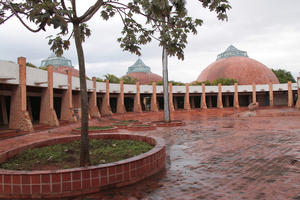
Cuba has also devoted considerable resources to formal art education. The Instituto Superior de Arte (ISA) is the premier college level school for five career paths: music, visual arts, theater arts, dance arts, and arts and audiovisual communication media. Award winning buildings on the main campus in Havana are round-domed, breast-like units, connected by loggia and interspersed with pools and sculpture in shapes suggestive of the female body. Tuition is free, but admission is highly competitive. The main campus sits on the former golf course of a pre-Revolution country club that was frequented by wealthy Cubans and Americans.
Cubans are fond of relating the anecdote that General Fulgencio Batista, while he was president of Cuba, was denied membership in the Havana Yacht Club because he was a couple of shades too dark. We don’t know if he was also turned down by the golf club, but a tour of the ISA facility indicated that the present student body is a healthy mix of gender and skin color, from café-au-lait to espresso.
The National Museum of Fine Arts in Havana has an imposing international collection but has concentrated on the works of the Cuban avante garde of the 20th Century, in particular that of Wilfredo Lam, considered the father of Cuban modern art. Lam was born in Cuba of Chinese and African parents in 1902 and died in Paris in 1982. As a young man he worked in Europe, meeting and studying with Picasso, Roualt, Brancusi, and others. He returned to Cuba to promote Afro-Cuban culture in visual arts, including themes derived from Santeria, to which he was an adherent. He supported student protests in the 1950’s and the Revolution of 1959, contributing murals in public buildings. He later established a school in Italy. His most famous painting, “The Jungle”, is in the Museum of Modern Art in New York.
One of our most remarkable encounters was with a collective of “Naïve”, or self-taught, painters from the sugar mill town of Mella near the city of Santiago, at the eastern end of the island. Luis Rodríguez Arias, called El Maestro, founded the group in the 1990s. His son, Luis Rodríguez Ricardo, who calls himself El Estudiante, now leads the collective, which consists of eight or nine residents of Mella who eschew formal training in the plastic arts, dispensing with techniques such as perspective, and concentrating on depictions of their lives, culture, recreation, and surroundings. Their paintings emphasize the blazing colors of the fields, hills, and rivers around them with special attention to the thousands of shades of green of the surrounding forest. Some works strongly resemble the forest paintings of French impressionist Henri Rousseau, who was also referred to as a “primitive” or “naive” artist. Luis, El Maestro, was a baker. Luis, El Estudiante, earned a degree in highway construction. Others in the collective worked in the sugar mill or served as policemen, lawyers, or doctors in Mella. Most continue in their regular jobs.
The Grupo Bayate has spawned two other collectives, one of which composed by women artists. The collectives’ works have been shown in many Cuban art spaces these past 15 years, and not just in Havana and Santiago. It has been seen in several exhibitions in New York as well, arranged by Sandra Levinson. The artists help support a civic center in Mella where they periodically have showings.
In Santiago, the Casa José María Heredia School for the Arts, an elementary and high school, is devoted to the musical and performing arts. Admission is open and graduates often qualify for the ISA. But even for those who don’t go on to the ISA, there is excellent training for professional or amateur participation in local and regional music, theater and dance organizations.
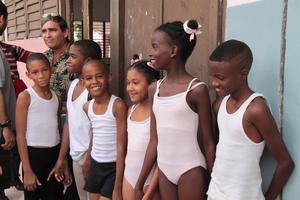
The students performed for us indoors and outdoors, for two hours. This included a Handel saxophone solo, a Brahms piano solo, and a quartet of ten year olds singing, of all things, “Give Me That Old Time Religion.” There was a ballet bar and traditional Cuban and Jazz dances. At the end of the dance numbers, the students dragged us onto the floor to dance and make fools of ourselves to their great delight. What struck us was not only the energy and high spirits of the students but the camaraderie and mutual support among the faculty and upper and elementary school students.
But because of the blockade/embargo, musical instruments and accessories are scarce. Students in the classes for wind instruments have to share one reed for the whole class. Ballet students have to make do with broken-in worn-out ballet shoes and the tap dancers are mostly without tap shoes.
After three days in Santiago, we flew back to Havana to meet Manuel Mendive. Manuel is, perhaps, Cuba’s best-known post-Revolution visual artist. He lives “in the country” a two-hour drive out of Havana in a sprawling, thickly wooded compound with a vista down a forested valley to the sea. Born in Cuba in 1944 of Afro-Cuban parents, he received formal training at the Academy of San Alejandro in Havana. But in 1963 he departed from formalism to pursue themes and visions based in African Yoruba culture and the Santeria religion. To get started, he made a deal with the artists’ agency that if it provided the means and materials to rebuild an old country lodge as a studio, he would turn over the money he made to the agency for 10 years. They did and he did. Now his large scale paintings and sculptures regularly bring in five figure prices. He employs many local residents as assistants and pays taxes. He could live anywhere in the world but is committed to Cuba. He has recently had a very successful showing in Los Angeles at the City African-American Museum.
A work of art himself, he is of imposing size, with a dramatic ebony face, snow-white beard and white dreadlocks. He wears a white muslin dashiki. Hollywood could cast him as a black Moses if not for his cheerful good humor and ever-present smile.
There were several interesting political discussions on the tour, but those that stand out were with José “Pepe” Viera and with the members of a Committee for Defense of the Revolution in a neighborhood in Santiago. Viera was First Deputy Minister of Foreign Affairs from 1981 to 1990. He has otherwise served the Revolution in many leadership capacities, including a stint as a member of the Cuban Mission to the United Nations in New York.
All 13 of us crowded into the living room of Pepe’s modest home and discussed Cuban and U.S. politics and economics for two hours. He frequently referenced the “Guidelines” which are, formally, the Economic and Social Policy Guidelines for the Party and the Revolution, a 19-page, single-spaced document finalized in 2011 after two years of debate, including submission of drafts to the people for comment through their Committees for the Defense of the Revolution
Our discussion with Pepe disclosed that, following the Guidelines, Cuba has cautiously begun a transition to a mixed economy with greater scope for private enterprise, but with government control of the major means of production and financial institutions and with a continuation of overall socialist planning. Throughout the Guidelines are admonitions to seek ways to shift financing of the provision of goods or services from the government budget to the private sector. This is stated in the section on culture as well. One can only hope that this does not result in fewer ISA’s and Casa José María Heredias, schools and more Tropicana floorshows.
Our meeting with a Committee for the Defense of the Revolution took place in a neighborhood in Santiago close to our hotel. The whole neighborhood, about 100, adults and children, turned out to welcome us. The gathering was held under a streetlight, which is where they hold their CDR meetings every other month. An old time revolutionary introduced us, children recited poems, and sang songs about Jose Martí, the national hero. There was music, dancing, and food. Everybody knew everybody and all were having a good time. Again, we were told to talk to anybody we wanted, so we did.
The Cuban people we met were proud of their country, its achievements and its art. They are well aware of the dismal state of pre-revolutionary health, medical services, education, literacy, life expectancy, and other basic human needs. They are proud of their successful resistance to the overt and covert attempts by the United States to effect “regime change” in Cuba. They will fight to defend their island and their social achievements. They proved this during the ill-fated, U.S.-sponsored Bay of Pigs invasion and during the years of shortages and extreme hardship that followed the collapse of Soviet markets and investment in the early 1990s—called “The Special Period.”
But now, having made these sacrifices, they want some of the basic consumer goods and services that those of us in the North take for granted—the kind that are best provided by small neighborhood enterprises like bodegas, shoe repair, auto repair, restaurants, plumbers, carpenters, art supplies, school supplies, and dry cleaners. They want more and better food. Many are already ahead of the government, providing some of these services without the sanction of the state, creating an underground economy that allows the formal structure to function without food riots breaking out. The government is moving to stimulate and encourage small businesses and diversified private or cooperative agriculture. But this takes time.
So there is tourism. In 2012, largely because of the relaxation of U.S. travel restrictions for Cuban families and for educational “people to people” exchanges, 400,000 U.S. citizens visited Cuba, spending hard currency to do so. A million Canadians, under no restrictions, also visited. Were all U.S. travel restrictions lifted, several million U.S. tourists could be expected to visit, providing Cuba the capital needed to hold civil society together while transitioning to a mixed economy.
On our last night in Havana, we had a farewell dinner at a place called El Templete, which caters to tourists who filled the place. Ordinary Cubans work there but can’t afford to eat there. During the long, dark walk back to the hotel, through foggy, dimly lit streets, we saw open transactions of prostitution and drug sales in cars and on foot. No one bothered us and the customers in the cars seemed to be Cubans, not Europeans or Canadians. But one wonders if the sellers would be there at all if not for the proximity of tourists with hard currency. Certainly, if we knew what was happening, the police must too.
The question arose as to whether, in light of the political imagery in many of the works we observed, Cuban art echoed Soviet Socialist Realism. Socialist Realism, however, was a narrow art form whose style and subject matter was mandated by Stalin in 1934. Approved artistic portrayals were limited to idealized Soviet workers, farmers, and soldiers in triumphant poses; avuncular pictures of Stalin; or renditions of Lenin, orating defiantly.
Cuban art is closer to a different tendency called Social Realism, which arose spontaneously during the early 20th Century. These works, artistic and photographic, portrayed in stark terms the hardship and suffering of the poor and working classes. These tragic conditions are what drove the artists emotionally and strongly influenced what they wanted to express.
For Cuban artists, contemporary political developments, including repeated threats from the United States and the Miami exiles, have been highly dramatic factors in Cuban life, so it is natural that political imagery will appear. And often this imagery is very subtle and ambiguous, particularly in radically conceptual pieces. But religion and sexuality are also significant social forces in Cuban society and, consequently, take their place in Cuban art.
Another common factor noted was the involvement of the artists in their communities and the consciousness of the community of the value of their art. This is not characteristic of most North American or European artists who tend to be reclusive, if not actually alienated, from their immediate social environment.
In addition to prioritizing universal basic human physical needs during difficult times, the revolutionary government has also prioritized artistic expression, a decision made 50 years ago, which has born the fruit of world renown for Cuba’s cultural achievements. What we saw and heard in Cuba was a comprehensive sampling of the explosion of Cuban art and culture since 1959. Technically constrained by material shortages, but unencumbered by Soviet-style diktats, this artistic outpouring can fairly be referred to as part of the expansive human flourishing envisioned as the ultimate goal of socialist revolution, all the more remarkable in an economy of scarcity.
Cuban Socialism is not just designed to meet basic human physical needs and provide an equitable system of wealth distribution. That is necessary but not sufficient for most people, at least, not indefinitely. The goal beyond that is the creation of the optimum conditions for individual and collective human development and expression—the creative thought and activity that makes life worth living for the creator and for society. Cuba has come a long way toward establishing those conditions for those who find fulfillment in the creation and appreciation of the arts.
Politically and economically, Cuba is at a critical juncture in its internal struggle to maintain a humane socialist economy and civil society and in its external struggle with the U.S. government As such, Cuba now, more than ever, needs active support from progressive North Americans to pressure the U.S. government to lift the embargo/blockade and to re-establish normal trade and diplomatic relations.
Dennis James is a retired attorney and published author of short stories and essays. He lives in Brooklyn, N.Y. with his wife, Barbara Grossman, who took the photos for this article.
Read the rest of NACLA's Summer 2013 issue: "Chavismo After Chávez: What Was Created? What Remains?"

